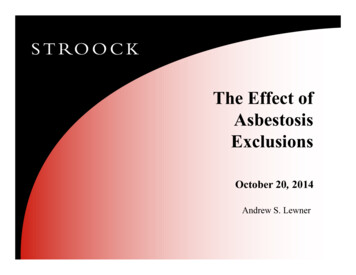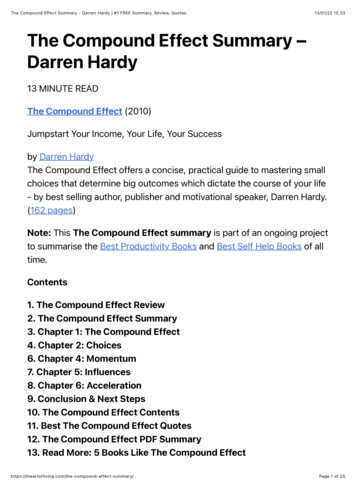
Transcription
The Effect ofAsbestosisExclusionsOctober 20, 2014Andrew S. Lewner
Does this exclusion bar all bodily injuryclaims resulting from exposure to asbestos? “In consideration of the premium charged it isagreed that coverage under this policy shall notapply in the case of any claim arising out ofASBESTOSIS.”
INSURANCE COVERAGE OFASBESTOSIS CLAIMS—RUNNING FORCOVER OR COVERAGE32 Emory L.J. 901 (1983)“Allasbestos-related diseases in this comment will bereferred to as ‘asbestosis.”’ The three most common job-related diseases contracted by asbestos workers are asbestosis,mesothelioma, and lung cancer. For a comprehensive explanation ofthese diseases, see Selikoff, Bader, Bader, Churg & Hammond,Asbestosis and Neoplasia, 42 AM. J. MED. 487 (1967) [hereinaftercited as Selikoff]; Seiker, Churg & Hammond, The Occurrence ofAsbestosis Among Insulation Workers in the United States, 132 N.Y.ACAD. SCI. ANN. 139 (1965); DRESSEN ET AL, A STUDY OFASBESTOSIS IN THE ASBESTOS TEXTILE INDUSTRY, PUBLICHEALTH BILL NO. 241 (1938).
Plain Meaning or “Parol Evidence” Rule “When parties set down their agreement in a clear,complete document, their writing should as a rulebe enforced according to its terms. Evidenceoutside the four corners of the document as towhat was really intended but unstated or misstatedis generally inadmissible to add to or vary thewriting.” WWW Assocs. v. Giancontieri, 77 NY 2d 157, 163(N.Y. 1990) The overwhelming majority of states follow theplain meaning or “parol evidence” rule.
UNR Indus., Inc. v. Cont'l Ins. Co.,1988 WL 121574 (N.D. Ill. Nov. 9, 1988) Both parties disputed the meaning of an exclusion providing that “Inconsideration of the premium charged it is agreed that coverage under thispolicy shall not apply in the case of any claim arising out ofASBESTOSIS.” The court initially found that the “asbestosis” exclusion unambiguouslyexcluded only claims arising from the disease asbestosis and issued asummary declaratory judgment on that basis. The insurers moved to amend the judgment and presented parole evidencedemonstrating that there were “many instances in which medical, legalexperts, and other insurance companies . . . have used the term asbestosis tomean ‘asbestos-related’ even though it can be shown to be incorrect from atechnical point of view.” The court granted the insurers’ motion andvacated the declaratory judgment, concluding that an issue of fact existedas to the meaning of the term asbestosis.
Highlands Ins. Co. v. Celotex Corp.,743 F. Supp. 28 (D.D.C. 1990) Plaintiff-insurers brought a declaratory judgment action against the defendantsseeking to exclude all coverage for asbestos-related diseases.At issue in this case were four exclusions:– (1) “claims made against the insured arising out of Asbestosis or anysimilar condition caused by Asbestos”;– (2) “bodily injury or property damage claim or claims arising out of allasbestosis operations is excluded from the policy”;– (3) “liability imposed upon the insured arising out of ASBESTOSIS”; and– (4) “liability for bodily injury, personal injury or property damagecaused by or arising out of asbestosis.”The court found all of the exclusions were ambiguous and that extrinsicevidence as to the subjective intent of the plaintiff would be needed. Basedupon factual evidence adduced at trial, the court held that the exclusionsexcluded all asbestos claims, and not just those for the disease asbestosis.
Carey Canada, Inc. v. Columbia Cas. Co.,940 F.2d 1548 (D.C. Cir. 1991) The following “asbestosis” exclusions were at issue in this case:– 1) “It is understood and agreed that any bodily injury or propertydamage claim or claims arising out of all asbestosis operations isexcluded from the policy.”– 2) “This policy shall not apply to any liability imposed upon theinsured arising out of ASBESTOSIS.” Relying on evidence of the parties’ subjective intent, the D.C. Circuit Courtof Appeals upheld the district court’s factual finding “that all parties knewand understood that the ‘asbestosis’ exclusions [at issue] applied to allasbestos-related disease claims.”
Matter of Celotex Corp., 175 B.R. 98(Bankr. M.D. Fla. 1994) Celotex Corp. and Carey Canada, Inc., bothrelated companies, filed for bankruptcy reliefunder Chapter 11. Insurers for both companies sought deny coveragefor non-asbestosis diseases based upon anexclusion for “asbestosis and related diseasesarising out of asbestos products.” The Court found the exclusion to beunambiguous, and to only exclude the diseaseasbestosis.
Owens-Illinois, Inc. v. United Ins. Co.,264 N.J. Super. 460 (App. Div. 1993) There were two exclusions at issue in this case.– The first, which was issued in 1980, provided that “[i]n considerationof the premium charged, it is understood and agreed that this certificatedoes not provide coverage for any claims arising from or due toasbestosis.”– The second, which was issued in 1983, substituted the word “asbestos”for “asbestosis.” The Court found that the earlier asbestosis exclusion did notembrace other asbestos-related diseases because “[f]or decades, thecourts have recognized what the medical community has longknown; asbestosis is a specific disease different from otherasbestos-related illnesses.” The Court found the insurers evidence as to the parties’ intentregarding the first exclusion was unpersuasive even though itrecognized that the words “asbestosis” and “asbestos” wereoccasionally used interchangeably.
AstenJohnson, Inc. v. Columbia Cas. Co.,562 F.3d 213 (3d Cir. 2009) The District Court ruled in favor of the insurer:– The District Court, based upon expert and fact witnesstestimony, held that in the insurance world of the 1980s, “theterm ‘asbestosis’ was used to mean two different things. First,the term was used to mean the specific asbestos-related diseasediscussed above and found in a medical dictionary. Second, itwas used as a generic term, i.e., an all encompassing term thatincludes all asbestos-related diseases.”– The District Court also found that the parties’ course ofperformance revealed that “Asten understood and intended theAsbestosis Exclusion to bar all claims alleging any asbestosrelated disease.” The Court of Appeals affirmed.
Andrew S. om
Highlands Ins. Co. v. Celotex Corp., 743 F. Supp. 28 (D.D.C. 1990) Plaintiff-insurers brought a declaratory judgment action against the defendants seeking to exclude all coverage for asbestos-related diseases. At issue in this case were four exclusions: - (1) "claims made against the insured arising out of Asbestosis or any










